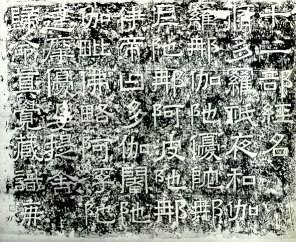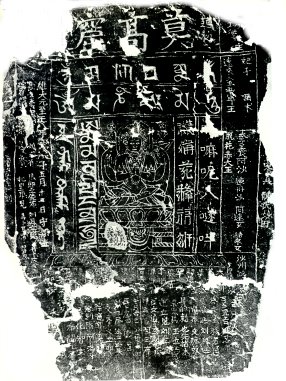| Contents
61. Fa Hsiang Sect (I)
61. Fa Hsiang Sect (I)
61.1 Name
Literally, Fa-hsiang [法相], which
is Dharma-laksana in Sanskrit, means 'the characteristics of Dharmas'
or 'the specific marks of Dharmas'. As Dharma is generally the existence
of both substantial matter and mental activities, this sect focuses
on the study of nature and qualities of all existences. This sect
is also classified as Realistic School [有宗].
This sect believes that only consciousness/ideation (Vijnana
in Sanskrit) exists in Dharmas, thus it is called 'Wei-shih' sect
[唯識], i.e. Mere-Consciousness Sect.
This sect originated in India, formerly called Yogacara. Yogacara
School was founded by Asanga, the elder of Vasubandhu, who wrote
an important text 'Yogacara-bhumi', after which the school was named.
Thus, Fa-hsiang Sect is sometimes called Yogacara Sect [瑜伽宗].
The doctrine adheres neither to the doctrine that all things
exist, nor to the doctrine that nothing exists, but firmly to the
Doctrine of Mean, so this school is classified as 'Idealistic School'
[相宗].
In China, this sect is also sometimes called Tzu-yun [慈恩]
sect. Tzu-yun is actually the name of the temple where the remarkable
second patriarch Kuei-chi [窺基] resides.
61.2 Historical
Development
61.2.1 In India
About 900 years after the Nirvana of Shakyamuni Buddha, the
great master used to ascend to Tusita Heaven every night to hear
the Dharma delivered by Matreiya, and returned to his lecture
hall by daytime preaching to his followers. His lectures were
recorded in the famous treatise called 'Yogacara-blumi Shastra'
[瑜伽師地論].
The treatise expounds the principle of the transformation
of consciousness, which was introduced by Shakyamuni Buddha in
Sandhinirmocana Sutra [解深密經] and
Lankavatara [楞伽經]. It also summarizes
systematically the Theory of Mere-Consciousness, which was elaborated
in several treatises written by the two brothers Asanga and Vasubandhu.
This school is commonly known as the Yogacara.
61.2.2 In China
 Having
traveled in India for 16 years in his pilgrimage, the great master
Hsuan-tsang returned to China in 645 AD, with numerous Buddha's
relics and images, and 657 Buddhist texts. He then concentrated
his work in editing and translating the texts to Chinese. One
of the important texts he translated was 'Treatise on the Establishment
of Mere Consciousness' [成唯識論],
which is the principal text of Fa-hsiang sect. Hsuan-tsang is
regarded as the first patriarch of Fa-hsiang sect in China. Having
traveled in India for 16 years in his pilgrimage, the great master
Hsuan-tsang returned to China in 645 AD, with numerous Buddha's
relics and images, and 657 Buddhist texts. He then concentrated
his work in editing and translating the texts to Chinese. One
of the important texts he translated was 'Treatise on the Establishment
of Mere Consciousness' [成唯識論],
which is the principal text of Fa-hsiang sect. Hsuan-tsang is
regarded as the first patriarch of Fa-hsiang sect in China.
In China, the forerunner of Fa-hsiang is another sect in China,
known as She-lun [攝論]. In 563 AD,
Paramartha translated one of the important Mahayana texts 'Mahayana-samparigraba'
[攝大乘論] written by Asanga, thus
laying the foundation of She-lun sect. It is noted that Paramartha
was also the founder of the realistic Chu-she [俱舍]
sect.
61.3 Principal
Texts
There are six sutras and eleven treatises in Fa-hsiang sect, though
some of them are not extant in China.
The six sutras are:
- The Avatamsaka Sutra / Flower Adornment Sutra [華嚴經]
- Sandhinirmocana Sutra / Sutra on the Explanation on Profound
and Secret Meaning [解深密經]
- Lankavatara Sutra [楞伽經]
- Tathagata Emerging Meritorious Virtue Adornment Sutra [如來出現功德莊嚴經]
- Abhidharma Sutra [阿毗達磨經]
- Hou-yen Sutra [厚嚴經]
The eleven treatises are:
- Yogacara-blumi Shastra [瑜伽師地論]

- Shastra on Twenty Stanzas of Mere Consciousness / Vimisatika-karika
[二十唯識論]
- Mahayana Samparigraha [攝大乘論]
- Shastra on Mahayana Adornment Sutra [大乘莊嚴經論]
- Shastra on Conditions of the Contemplation of the Conditioned
[觀所緣緣論]
- Shastra on Dasabhumika Sutra [十地經論]
- Shastra on Abhidharmas [阿毗達磨雜集論]
- Shastra on Propagation of Sagely Teachings [顯揚聖教論]
- Shastra on Discriminative Yogacara [分別瑜伽論]
- Shastra on Determination of Mean and Extremes [辨中邊論]
- Ji-liang Shastra [集量論]
There are other important texts, such as:
- The Treatise on the Establishment of Mere Consciousness [成唯識論]
-- the fundamental treatise of Fa-hsiang sect written by the founder
Master Hsuan-tsang [玄奘]
- Vijnati-matrata-trimsika / Thirty Stanzas on Mere Consciousness
[三十唯識頌] -- written by Vasubandhu.
The first 24 stanzas are devoted to the special character (Svlakasana)
of all Dharmas, the next two to the nature (Svabhava) of all Dharmas,
the last four to the ten stages to Buddhahood.
61.4 Classification
of the Buddhist Teaching
This sect classifies the Buddha's teachings into three periods:
- Elementary Teaching - After the enlightenment of Shakyamuni
Buddha, he preached the teaching of Five Skandhas in Agamas
Sutra, which rejected the doctrine of 'self in reality' advocated
by the heterodox religions. It is the period that self is empty
and Dharma is existent.
- Emptiness Teaching - Later, the Buddha preached the teaching
of Prajna and exponded the doctrines on emptiness. Both self and
Dharmas are empty in nature.
- Middle Path Teaching - In Sandhinirmocana Sutra, the Buddha
explained the profound meaning of Middle Path, which rejected
those who attached to either 'existence' or 'emptiness', and explained
the inter-dependency of the existence of True Mind and the emptiness
of all phenomena. Fa-hsiang sect was established in accordance
with the teaching of Middle Path.
|

